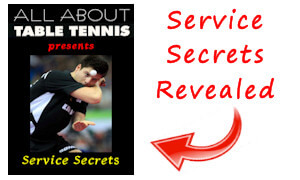You Are Here: Home » Visitor Questions » When should the umpire call the score?
Table Tennis Question
When should the umpire call the score?
This question about calling the score was submitted by
John from Devon, UK
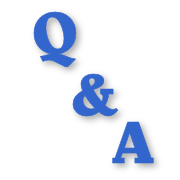
My question is about when the umpire should call the score.
Recently an umpire called the score and the server served.
The opponent said that he wasn't ready and the umpire called a let.
In my view the umpire should call the score only when he/she considers both players are ready.
It is up to the opponent then to be ready for the serve and not up to the server to check if the opponent is ready.
Moreover, when the umpire has called the score, the server is concentrating hard on executing the serve and should not have, at that point, the burden of checking the readiness of his opponent.
That readiness has surely been signaled by the announcement of the score.
My view was countered by a player who said that the score should be announced immediately a point has been scored.
This seems ridiculous to me as a ball may have to be retrieved a long way off etc.
Also, surely an umpire has an obligation to announce the score at a point that assures the appropriate pace of the game?
I have looked on the internet for an answer to my question but have been unsuccessful.
Please Martin can you help?
Thank you!
TABLE TENNIS EXPERT
REVEALS HIS SECRETS
Click Here For Details

Click here for a large selection of
table tennis equipment at Megaspin *

Click here for a large selection of
table tennis equipment at Bribar *
^ Top of page ^
----- Martin's Reply -----
By Martin Hughes
Owner and Editor
John,
Thanks for your question.
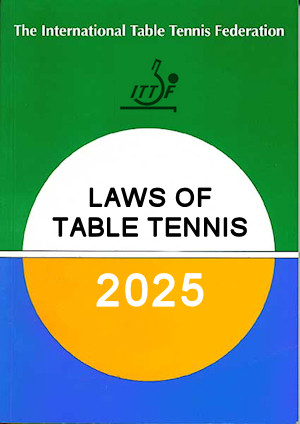
Before I answer your question directly, it's important to know about the difference between the "Laws of Table Tennis" and the International "Regulations" because the answer to your question can be found in the "Regulations".
The Laws of Table Tennis (commonly referred to as the rules of table tennis) are just the "basic" rules of table tennis which means they only prescribe the equipment to be used; how to serve and return; the order of play; how to score points and how long the game can last - whereas the International "Regulations" deal with everything else.
TABLE TENNIS EXPERT
REVEALS HIS SECRETS
Click Here For Details

Click here for a large selection of
table tennis equipment at Megaspin *

Click here for a large selection of
table tennis equipment at Bribar *
The Laws of Table Tennis are mandatory for all sanctioned table tennis events, but the Regulations are only mandatory for International events, although they can be used in non-International events.
So what this means is that most organised table tennis events will use at least some of these additional Regulations so that they'll be consistent in dealing with situations which aren't covered by the basic Laws of Table Tennis.
^ Top of page ^
So let's take a look at what the International Regulations say about calling the score...
Umpire Calling The Score
At the start of a game the umpire should announce the family-name/surname of the player who is serving first, followed by the score.
So, for example, the umpire would announce... "Smith to serve", "Love all" (or "Zero-Zero")
The score 0 can be expressed as either "love" or "zero".
When each player or pair has scored an equal number of points (for example 4 points each), the score may be called either as "4-4" or "4-all".
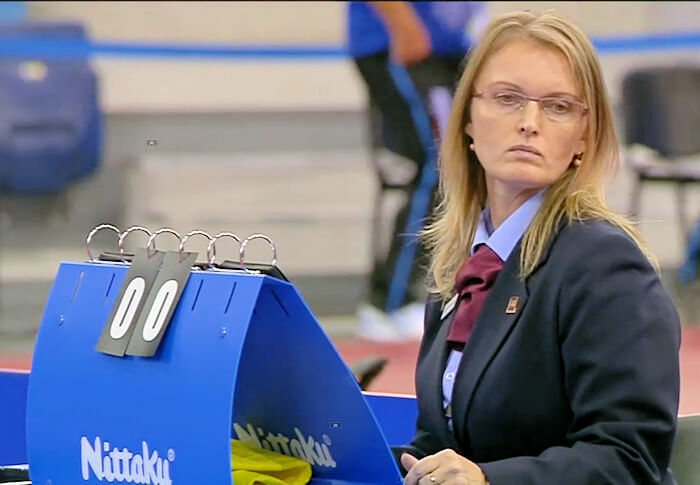 Assistant umpire with scoreboard
Assistant umpire with scoreboard
During a game, the International Regulations say that umpires should normally call the score as soon as the rally has been decided and that they shouldn't wait until they judge that the players are ready to resume play.
However, if there's loud applause or a player is retrieving the ball from the back of the playing area, they can delay it slightly until they're satisfied that both players or pairs will be able to hear it.
The umpire will then call the score by saying the number of points scored by the player (or pair) due to serve in the next rally, followed by the number of points scored by the opposing player (or pair).
If the rally is a let, the umpire should repeat the existing score to confirm that no point has been scored.
^ Top of page ^
The International Regulations also deal with the speed of play, and they say that "play shall be continuous throughout an individual match".
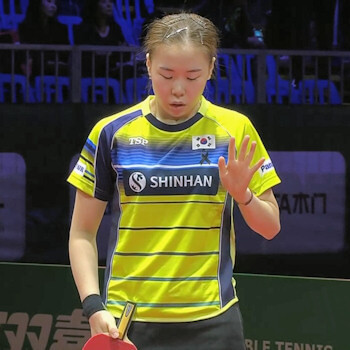 "Not ready" hand signal by player
"Not ready" hand signal by player
However, if a player isn't ready, they're normally expected to raise their hand to indicate that they're not ready.
It's then up to the umpire to decide whether to call a let, but only if the receiver makes no attempt to return the ball.
But just because the receiver makes no stroke doesn't itself justify a let. The umpire must decide whether the receiver was really unready or, perhaps, merely unwilling to try to return what appeared to be a difficult service.
However, if the umpire notices that the receiver is not ready when the server is about to serve, the umpire will usually call a let whether the receiver raises their hand or not.
If the receiver is a persistent offender, and thought to be trying to delay the game, the umpire could give a verbal warning and/or issue a yellow card (if the International Regulations dealing with yellow/red cards are being used).
^ Top of page ^
So you should always check in advance, about the...
Laws and Regulations which apply
When you're playing in a table tennis event, it's important to know which Regulations are being used by the organiser.
As I said earlier, the Regulations are primarily intended for International events, but they can be used in any table tennis event.
You should therefore always check what the entry form or prospectus or rule-book states, for the event you're playing in.
For lower-level events, few or even none of the International Regulations may be in use.
In that scenario, if a situation arises which isn't covered by the Laws, and the relevant Regulation isn't being used, then consensus has to be reached between the players taking part as to how to proceed.
^ Top of page ^
| FIND MORE TABLE TENNIS QUESTIONS ASKED BY MY VISITORS | |
|---|---|
 |
|
| FIND MORE TABLE TENNIS QUESTIONS ASKED BY MY VISITORS |
|---|
 |
| Find more table tennis questions already asked and answered |
^ Top of page ^
| MORE PAGES ABOUT THE RULES OF TABLE TENNIS |
|---|
For more information about the rules of table tennis, take a look at my other articles which explain the Official
Laws of Table Tennis and the additional Regulations (for higher level play) in more detail...
The Laws of Table Tennis
Regulations (for higher level play)
General
Frequently Asked Questions
|
Click here for a large selection of
table tennis equipment at Megaspin *

Click here for a large selection of
table tennis equipment at Bribar *
^ Top of page ^
You Are Here: Home » Visitor Questions » When should the umpire call the score?
